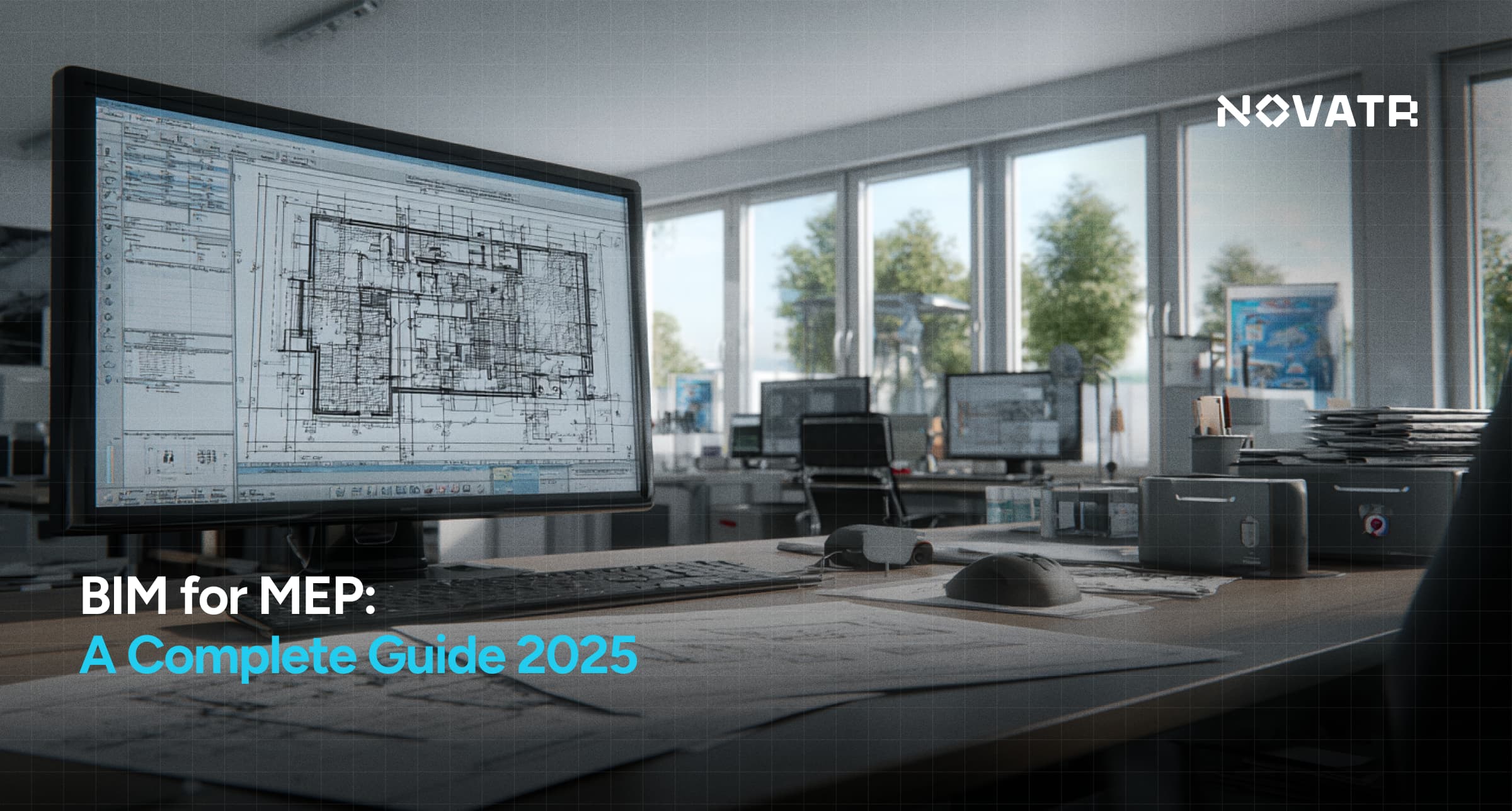
Ashdeep Singh is a BIM Manager who completed his B.Arch from Amity University. Currently working with Novatr, he has contributed to major projects including the Diriyah Arena in Saudi Arabia and the New Life Arena in Chennai. You can connect with him on LinkedIn to learn more about his professional journey and expertise in Building Information Modelling (BIM).
The move from 2D CAD drafting to BIM workflows is reshaping how architectural and construction professionals design and collaborate. What was once a collection of disconnected drawings has evolved into data-rich, model-based workflows that improve coordination, visualisation, and project accuracy. Yet, the transition isn’t always smooth. Moving from AutoCAD to BIM isn’t just adopting new software; it’s a complete shift in mindset, process, and collaboration.
Why Moving from 2D CAD to BIM Is Critical
Moving from 2D CAD to BIM is critical since BIM creates a coordinated, data‑rich 3D model that all verticals and teams share, cutting clashes and rework while improving speed and accuracy. It enables real‑time collaboration, automatic quantities, 4D/5D planning, performance analysis, and a maintainable digital twin for operations, delivering better outcomes across the building lifecycle.
Limitations of 2D CAD in Modern Project Coordination
Traditional CAD workflows rely on separate 2D drawings for plans, sections, and elevations. Each change must be updated manually across all drawings, a time-consuming process prone to errors and inconsistencies. Coordination between disciplines such as architecture, structure, and MEP (mechanical, electrical, plumbing) often happens late in the project, leading to costly on-site clashes.
Clients, too, struggle to interpret flat drawings. Without a clear visual understanding, revisions come late, and design intent can be lost.
Benefits of BIM for Visualisation, Collaboration, and Accuracy
With Building Information Modelling (BIM), architects create intelligent 3D models embedded with real data. Drawings, schedules, and documentation are all generated from a single model, ensuring accuracy, consistency, and efficiency.
BIM facilitates real-time collaboration between architects, engineers, and consultants through tools like Autodesk Revit, Navisworks, and Autodesk Construction Cloud. Visualisation tools such as Enscape or Twinmotion allow stakeholders to experience immersive 3D walkthroughs, while 4D BIM links construction sequencing to the model, helping teams track progress over time.
Key Skills Architects Need to Successfully Transition
Transitioning to BIM isn’t about mastering new software commands; it’s about adopting a data-driven, collaborative approach to design. Architects need to balance technical proficiency with conceptual understanding.
Architects moving from 2D CAD to BIM need parametric modelling (Revit/ArchiCAD), rigorous information management (naming, parameters, standards), and coordination in shared models with clash detection and a BIM Execution Plan. Generate documentation and quantities from the model, ensure IFC interoperability, prepare for analysis (energy/daylight/4D‑5D), audit quality (LOD/LOI), communicate data‑backed options, adopt process‑driven workflows, and keep learning about plugins, cloud, and automation.
Essential BIM Skills for Architects
Key skills for a successful BIM transition include:
- Understanding BIM principles, dimensions, and standards
- Mastering parametric modelling and managing families and parameters
- Coordinating multidisciplinary models (architecture, structure, and MEP)
- Using cloud-based collaboration tools for shared workflows
- Conducting clash detection and model validation in Navisworks
- Integrating models with time and cost data (4D and 5D BIM)
- Automating tasks with Dynamo
- Maintaining naming conventions, templates, and documentation standards
- Enhancing presentation using real-time rendering software
Prioritising Learning When Shifting from CAD to BIM
For those starting, begin with small-scale projects. Rebuild one of your previous CAD designs in BIM to understand the differences in workflow. Focus on achieving precision in modelling and annotation rather than rushing to produce visual renders. Gradually incorporate Autodesk Docs and Navisworks into your routine.
Collaboration is key to linking models with other disciplines early to understand real coordination workflows. Every project you work on should help you refine your BIM standards and templates.
Also Read: How Revit is Used for Structure Design: A Comprehensive Overview
Common Pitfalls During the Transition
Many architects stumble because they assume BIM is just 3D AutoCAD. They rush into modelling without setting up proper project foundations or understanding how parameters control data. Without a project template, naming standards, shared parameters, and a BIM Execution Plan, models bloat, views desync, and data becomes unreliable. BIM is a data-centric, collaborative process. Start with standards, parameters, and coordination rules before modelling to prevent rework and enable automation, analysis, and accurate deliverables.
Frequent Mistakes in BIM Adoption
Some mistakes that professionals commonly end up making are:
- Skipping proper project setup (levels, grids, and coordinates)
- Using excessive 2D lines instead of real components
- Ignoring naming conventions and file structures
- Overloading models with unnecessary detail
- Failing to collaborate or coordinate with other teams
- Avoiding worksharing or cloud tools due to unfamiliarity
- Neglecting clash detection and data management workflows
How to Avoid These BIM Mistakes
Success begins with a strong foundation. Establish a BIM Execution Plan (BEP) before modelling. Treat BIM as a process for managing building data, not just visualising geometry. Use parametric, reusable families instead of in-place components.
Here’s how to avoid these mistakes:
1. Set the foundation
Establish a BIM Execution Plan (BEP) before any modelling.
Treat BIM as a data‑management process, not just 3D visuals.
2. Model the right way
Use parametric, reusable families; avoid in‑place components.
Keep models lean; model only what’s needed for the current stage.
3. Standardise and organise
Apply consistent naming conventions, worksets, and view templates.
Define shared parameters and object standards from day one.
4. Maintain quality
Schedule regular model audits to monitor size, warnings, and errors.
Validate LOD/LOI and parameter completeness periodically.
5. Coordinate early and often
Collaborate frequently across disciplines to catch issues early.
Run coordinated reviews/clash checks on a defined cadence and resolve promptly.
Keep your model lean; only include what’s necessary for the project stage. Follow consistent naming conventions and view templates. Schedule regular model audits to maintain performance and accuracy. Most importantly, collaborate frequently with all disciplines to catch issues early and ensure smooth coordination.
Also Read: How BIM was Used to Ease the Construction of Abu Dhabi International Airport?
Future Outlook: BIM as the Standard in Architecture
Over the next five years, BIM will be the industry standard for design and construction. BIM is rapidly becoming the default for delivery, driven by mandates and measurable gains in cost, time, and carbon. Over the next five years, UK and global firms will standardise on model‑based workflows for design, coordination, and asset management. BIM literacy will be essential for employability, collaboration, and lifecycle outcomes across AEC.
Here’s how BIM will shape architectural careers:
-
Specialised Roles: Positions like BIM Coordinator, Digital Delivery Lead, and VDC Specialist are becoming standard roles within firms.
-
Data-Centric Practice: Architects will increasingly rely on data analytics, performance modelling, and lifecycle management.
-
Global Collaboration: Cloud-based BIM allows professionals to contribute to international projects remotely.
-
Higher Earning Potential: BIM professionals can earn 30–40% more than traditional CAD-based roles.
-
Continuous Learning: With AI, digital twins, and automation becoming part of BIM ecosystems, upskilling will be essential to stay relevant.
Advice for Architects Preparing for the Digital Transition
Don’t wait for a “BIM project” to begin your learning journey. Rebuild one of your old CAD projects in Revit to experience the difference in efficiency and documentation. Master Revit, explore Navisworks and Dynamo, and learn to use cloud collaboration tools effectively. Prioritise clean modelling, accurate data entry, and proper documentation from the outset.
Conclusion
The transition from 2D CAD to BIM represents a major evolution in how architects work from drawing to data, from isolation to collaboration. While it requires dedication and a mindset shift, the payoff is immense: improved coordination, fewer errors, better visualisation, and stronger career prospects.
For architects in the UK looking to future-proof their careers, enrolling in a Novatr's BIM Course for Architects is an excellent step. Platforms like Novatr offer structured, industry-led training in Revit, Navisworks, Dynamo, and BIM management workflows, preparing professionals to lead digital transformation in architecture and design.
Was this content helpful to you




.jpg)


